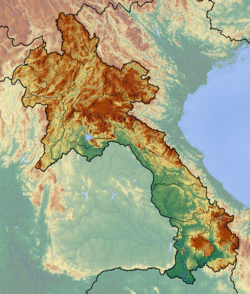Portal:Laos/Intro
Laos (/ˈlɑːoʊs/ ⓘ, /ˈlaʊs/, /ˈlɑːɒs/, or /ˈleɪɒs/; Lao: ລາວ, Lao pronunciation: [láːw], Lāo), or commonly referred to its colloquial name of Muang Lao (Lao: ເມືອງລາວ, Muang Lao), is a landlocked country in the heart of the Indochinese peninsula of Mainland Southeast Asia, bordered by Myanmar (Burma) and China to the northwest, Vietnam to the east, Cambodia to the southwest, and Thailand to the west and southwest. It traces its historic and cultural identity to the kingdom of Lan Xang Hom Khao (Kingdom of a Million Elephants Under the White Parasol), which existed for four centuries as one of the largest kingdoms in Southeast Asia. Due to Lan Xang's central geographical location in Southeast Asia, the kingdom was able to become a popular hub for overland trade, becoming wealthy economically as well as culturally. After a period of internal conflict, Lan Xang broke off into three separate kingdoms — Luang Phrabang, Vientiane, and Champasak. In 1893, it became a French protectorate, with the three territories uniting to form what is now known as the country of Laos. It briefly gained freedom in 1945 after Japanese occupation, but was recolonised by France until it won autonomy in 1949. Laos became independent in 1953 under King Sisavang Vong. The capital city is Vientiane. Other large cities include Luang Prabang, Savannakhet, and Pakse. The official language is Lao. Laos is a multi-ethnic country with the politically and culturally dominant Lao people making up approximately 60 percent of the population, mostly in the lowlands. Mon-Khmer groups, the Hmong, and other indigenous hill tribes, accounting for 40 percent of the population, live in the foothills and mountains. Laos' ambitious strategies for development are based on generating electricity from its rivers and selling the power to its neighbors, namely Thailand, China, and Vietnam, as well as its initiative to become a 'land-linked' nation, shown by the planning of four new railways connecting Laos to those same countries. This, along with growth of the mining sector, Laos has been referred to as one of East Asia and Pacific's fastest growing economies by the World Bank, with annual GDP growth averaging 7% for the past decade. It is a member of the Asia-Pacific Trade Agreement (APTA), Association of Southeast Asian Nations (ASEAN), East Asia Summit and La Francophonie. Laos became a member of the World Trade Organization (WTO) in 2013. Selected article -CIA activities in Laos started in the 1950s. In 1959, U.S. Special Operations Forces (Military and CIA) began to train some Laotian soldiers in unconventional warfare techniques as early as the fall of 1959 under the code name "Erawan". Under this code name, General Vang Pao, who served the royal Lao family, recruited and trained his Hmong and Iu-Mien soldiers. The Hmong and Iu-Mien were targeted as allies after President John F. Kennedy, who refused to send more American soldiers to battle in Southeast Asia, took office. Instead, he called the CIA to use its tribal forces in Laos and "make every possible effort to launch guerrilla operations in North Vietnam with its Asian recruits." General Vang Pao then recruited and trained his Hmong soldiers to ally with the CIA and fight against North Vietnam. The CIA itself claims that the CIA air operations in Laos from 1955 to 1974 were the "largest paramilitary operations ever undertaken by the CIA." For 13 years, the CIA paramilitary officers from what is now called Special Activities Center directed native forces against North Vietnamese forces to a standstill. The CIA particularly organized Hmong people to fight against the North Vietnamese-backed Pathet Lao. The Pathet Lao were the communists in Laos. The CIA-backed Hmong and Iu Mien guerrillas used Air America to "drop 46 million pounds of foodstuffs. ... transport tens of thousands of troops, conduct a highly successful photo-reconnaissance program, and engage in numerous clandestine missions using night-vision glasses and state-of-the-art electronic equipment." This was the largest paramilitary operation in which the CIA participated, spanning 13 years until the Afghanistan War. The CIA was responsible for directing natives of Laos to fight the North Vietnamese. Although such efforts were ended at the 1973 signing of the Paris Peace Accords, the CIA believed it a success as it managed to fight the enemy to a standstill and combat the communist threat. They saw it as a victory and as an accomplishment. The director at the time, Richard Helms, called it superb and discussed the amount of manpower required, and that the CIA did a good job in supplying it. (Full article...)General images -The following are images from various Laos-related articles on Wikipedia.
Related portalsSoutheast Asia Other Countries Selected biography -Major-General Kouprasith Abhay (Lao: ກຸປຣະສິທທິ໌ ອະພັຍ; nicknamed 'Fat K'; 1926–1999?) was a prominent military leader of the Kingdom of Laos during the Laotian Civil War. Scion of a socially prominent family, his military career was considerably aided by their influence. In early 1960, he was appointed to command of Military Region 5, which included Laos' capital city, Vientiane. Removed from that command on 14 December for duplicitous participation in the Battle of Vientiane, he was reappointed in October 1962. He would hold the post until 1 July 1971, thus controlling the troops in and around the capital. Over the years, he would be involved in one way or another in the coups of 1960, 1964, 1965, 1966, and 1973. His service was marked by a deadly feud with another Laotian general, Thao Ma; the feud was largely responsible for the latter two coup attempts against the government. After the Royal Lao Government fell to the communists in 1975, Kouprasith retired to exile in France. (Full article...)Selected pictureWikiProjects
TopicsCategoriesDid you know?
Tasks
Associated WikimediaThe following Wikimedia Foundation sister projects provide more on this subject:
ContributorsDiscover Wikipedia using portals | |||||||||
































































